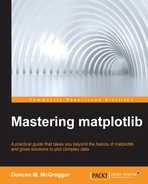In just over a decade, matplotlib has grown to offer the Python scientific computing community a world-class plotting and visualization library. When combined with related projects, such as Jupyter, NumPy, SciPy, and SymPy, matplotlib competes head-to-head with commercial software, which is far more established in the industry. Furthermore, the growth experienced by this open source software project is reflected again and again by individuals around the world, who make their way through the thorny wilds that face the newcomer and who develop into strong intermediate users with the potential to be very productive.
In essence, Mastering matplotlib is a very practical book. Yet every chapter was written considering this learning process, as well as a larger view of the same. It is not just the raw knowledge that defines how far developers progress in their goal. It is also the ability of motivated individuals to apply meta-levels of analysis to the problem and the obstacles that must be surmounted. Implicit in the examples that are provided in each chapter are multiple levels of analysis, which are integral to the mastery of the subject matter. These levels of analysis involve the processes of defining the problem, anticipating potential solutions, evaluating approaches without losing focus, and enriching your experience with a wider range of useful projects.
Finding resources that facilitate developers in their journey towards advanced knowledge and beyond can be difficult. This is not due to the lack of materials. Rather, it is because of the complex interaction of learning styles, continually improving codebases with strong legacies, and the very flexible nature of the Python programming language itself. The matplotlib developers who aspire to attain an advanced level, must tackle all of this and more. This book aims to be a guide for those in search of such mastery.
Chapter 1, Getting Up to Speed, covers some history and background of matplotlib, goes over some of the latest features of the library, provides a refresher on Python 3 and IPython Notebooks, and whets the reader's appetite with some advanced plotting examples.
Chapter 2, The matplotlib Architecture, reviews the original design goals of matplotlib and then proceeds to discuss its current architecture in detail, providing visualizations of the conceptual structure and relationships between the Python modules.
Chapter 3, matplotlib APIs and Integrations, walks the reader through the matplotlib APIs, adapting a single example accordingly, examines how third-party libraries are integrated with matplotlib, and gives migration advice to the advanced users of the deprecated pylab API.
Chapter 4, Event Handling and Interactive Plots, provides a review of the event-based systems, covers event loops in matplotlib and IPython, goes over a selection of matplotlib events, and shows how to take advantage of these to create interactive plots.
Chapter 5, High-level Plotting and Data Analysis, combines the interrelated topics, providing a historical background of plotting, a discussion on the grammar of graphics, and an overview of high-level plotting libraries. This is then put to use in a detailed analysis of weather-related data that spans 120 years.
Chapter 6, Customization and Configuration, covers the custom styles in matplotlib and the use of grid specs to create a dashboard effect with the combined plots. The lesser-known configuration options are also discussed with an eye to optimization.
Chapter 7, Deploying matplotlib in Cloud Environments, explores a use case for matplotlib in a remote deployment, which is followed by a detailed programmatic batch-job example using Docker and Amazon AWS.
Chapter 8, matplotlib and Big Data, provides detailed examples of working with large local data sets, as well as distributed ones, covering options such as numpy.memmap, HDF5, and Hadoop. Plots with millions of points will also be demonstrated.
Chapter 9, Clustering for matplotlib, introduces parallel programming and clusters that are designed for use with matplotlib, demonstrating how to distribute the parts of a problem and then assemble the results for analysis in matplotlib.
